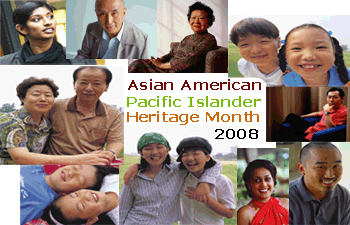|
Last Modified: May 13, 2008
Last Reviewed: May 13, 2008
Content Source:
Office of Minority Health & Health Disparities (OMHD) |
 |
Highlights in Minority Health
& Health Disparities
May, 2008

|
|
|
MAY IS ASIAN
AMERICAN AND PACIFIC ISLANDER HERITAGE MONTH |
| During the observance of Asian American
and Pacific Islander (AAPI) Heritage Month, we celebrate the
cultural traditions, ancestry, native languages, and unique
experiences represented among more than 47 ethnic groups from Asia
and the Pacific Islands (speaking over 100 languages) who live in
the United States. We also recognize millions of AAPIs whose love of
family, hard work, and community has helped unite us as a people and
sustain us as a Nation.1 |
| AAPIs
represent one of the fastest-growing and most diverse populations in
the United States.2 According
to the 2003 President’s Advisory Commission on Asian Americans and
Pacific Islanders, Report to the President and the
Nation, AAPIs comprise many populations that make
critically important contributions to American life. Their
communities often are described as a “model minority” that
generally enjoys superior health status. However, in reality,
the AAPI population experiences genuine health disparities in
cancer screening, diabetes, and infectious diseases, among others.3 |
|
Top
of Page |
|
ASIAN AMERICANS |
|
Asian Americans
represent the extremes of both socioeconomic and health indices: |
 |
Asian American women
experience
the greatest life expectancy (85.8 years) of any other ethnic group
in the U.S.3 |
 |
Asian Americans have
the highest proportion of college graduates of any racial or ethnic
group (44.1% of Asian Americans have a bachelor’s degree, compared
with 24.4% of the total population).4 |
 |
Asian Americans contend with numerous factors which may threaten
their health, including infrequent medical visits
due to the fear of deportation, language/cultural barriers, and the
lack of health insurance. |
 |
Asian Americans are at
a greater risk for: cancer, heart disease,
stroke, unintentional injuries (accidents), and diabetes.3 |
 |
Asian Americans also have a
high prevalence and risk factors for:
chronic obstructive pulmonary disease, hepatitis B, HIV/AIDS,
smoking, tuberculosis, and liver disease.3 |
|
Top
of Page |
|
NATIVE HAWAIIANS
AND OTHER PACIFIC ISLANDERS (NHOPIs) |
The
U.S.-associated Pacific Island Jurisdictions
comprises
three Flag Territories: |
| American Samoa |
| the Commonwealth of the
Northern Mariana Islands (CNMI) |
| Guam |
|
|
and three Freely Associated States: |
| The Federated States of
Micronesia (FSM) |
| The Republic of the
Marshall Islands (RMI) |
| The Republic of Palau3
|
|
|
They are U.S. territories made up of hundreds of small islands and
atolls spread across about 5 million square miles of ocean—nearly
half the size of the United States—with a total population of
469,356 (1999 and 2000 estimates).5 |
|
It is significant to note
that in comparison to other ethnic groups, Native
Hawaiians/Pacific Islanders have higher rates of smoking, alcohol
consumption, and obesity.6 Major causes of premature death
among NHOPIs are obesity, cardiovascular diseases, cancer, and
diabetes. 6 |
|
Top
of Page |
|
EXAMPLES OF
IMPORTANT HEALTH DISPARITIES EXPERIENCED BY ASIAN AMERICANS
/ NATIVE HAWAIIANS & OTHER PACIFIC ISLANDERS |
| |
 |
The 5-year relative survival rate for all
cancers for Native Hawaiians is 47%, compared with 57% for whites
and 55% for all races.5 |
| |
 |
In 2005, Asian American women (ages 18+)
were least likely to have had a Pap test (64.4%) compared with other
racial/ethnic women (non-Hispanic white: 77.7%, non-Hispanic black:
81.1%, Hispanic/Latino: 75.5%, American Indian/Alaska Native: 75.2%.
7 |
| |
 |
In 2002*,
the infant mortality rate for Native Hawaiians was 9.6 per 1,000
live births, higher than the rate for all AAPIs combined (4.8), and
for all populations (7.0).
8 |
| |
 |
In 2005, AAPIs aged 40 years and older were
1.2 times more likely
to have Hepatitis B (3.5 per 100,000) than non-Hispanic whites
(2.9).9 |
|
Top
of Page |
|
FOR MORE
INFORMATION |
| |
Asian American Populations |
| |
Native Hawaiian and Other Pacific Islander Populations |
| |
White House Proclamation: Asian/Pacific American Heritage Month 2008 |
|
SOURCES |
| |
1. |
The White House Initiative on Asian Americans and Pacific Islanders,
President Celebrates APA Heritage Month at White House, 2002 |
| |
2. |
U.S. Environmental Protection Agency (EPA), Asian American and
Pacific Islander – Primer, 2006 |
| |
3. |
U.S. Department of Health and Human Services (HHS), Office of
Minority Health Resource Center (OMHRC), Asian American / Pacific
Islander Profile |
| |
4. |
U.S. Census Bureau, Educational Attainment 2000 |
| |
5. |
Centers for Disease Control and Prevention (CDC), National Center
for Chronic Disease Prevention and Health Promotion (NCCDPHP),
Health Disparities Among Native Hawaiians and Other Pacific
Islanders Garner Little Attention, Chronic Disease Notes and
Reports, 15 (2): 14-27 |
| |
6. |
HHS, OMHRC, Native Hawiian / Other Pacific Islander Profile |
| |
7. |
CDC, NCHS, Health US 2007, table 88 |
| |
8. |
CDC, NCHS, Health US 2007, table 19 |
| |
9. |
HHS, OMH, Immunizations and Asians and Pacific Islanders, 2005 |
|
NOTES |
| |
* |
Starting with 2003 data,
estimates are not shown for Asian or Pacific Islander subgroups
during the transition from single race to multiple race reporting in
Source 8. |
|
|


